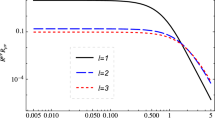Abstract
We compare families of simple periodic orbits of test particles in the Newtonian and relativistic problems of two fixed centers (black holes). The Newtonian problem is integrable, while the relativistic problem is highly non-integrable.
The orbits are calculated on the meridian plane through the fixed centersM 1 (atz=+1) andM 2 (atz=−1) for energies smaller than the escape energyE=1. We use prolate spheroidal coordinates (ψ, ϑ, ϕ=const) and also the variables λ=cosh ψ and μ=−cos ϑ. The orbits are inside a curve of zero velocity (CZV). The Newtonian orbits are also limited by an ellipse and a hyperbola, or by two eillipses. There are 3 main types of periodic orbits (1) elliptic type (around both centers), (2) hyperbolic-type, and (3) resonant-type.
The elliptic type orbits are stable in the Newtonian case and both stable and unstable in the relativistic case. From the stable orbits bifurcate double period orbits both symmetric and asymmetric with respect to thez-axis. There are also higher order bifurcations. The hyperbolic-type orbits are unstable. The Newtonian resonant orbits are defined by the ratiot µ/t λ=n/m of oscillations along λ and μ during one period, and they are all marginally unstable. The corresponding relativistic orbits are stable, or unstable. The main families are figure eight orbits aroundM 1, or aroundM 2 (3/1 orbits); gamma, or inverse gamma orbits (4/2); higher resonant families 5/1,7/1,...,8/2,12/2,...;, more complicated orbits, like 5/3, and bifurcations from the above orbits. Satellite orbits aroundM 1, orM 2, and their bifurcations (e.g. double period) exist in the relativistic case but not in the Newtonian case. The characteristics of the various families are quite different in the Newtonian and the relativistic cases. The sizes of the orbits and their stabilities are also quite different in general. In the Appendix we study the various types of straight line orbits and prove that some subcases introduced by Charlier (1902) are impossible.
Similar content being viewed by others
References
Arnold, V.I.: 1978,Mathematical Methods of Classical Mechanics, Springer Verlag.
Chandrasekhar, S.: 1983,The Mathematical Theory of Black Holes, Oxford Univ. Press.
Chandrasekhar, S.: 1989,Proc. Roy. Soc. A421, 227–258.
Charlier, C.L.: 1902,Die Mechanik des Himmels, von Veit, Leipzig.
Contopoulos, G.: 1990,Proc. Roy. Soc. A431, 183–202.
Contopoulos, G.: 1991,Proc. Roy. Soc. A435, 551–562.
Hénon, M.: 1965,Ann. Astrophys. 28, 992–1007.
Majumdar, S.D.: 1947,Phys. Rev. 72, 390–398.
Papapetrou, A.: 1947,Proc. R. Irish Acad. 51, 191–205.
Szebehely, V.: 1967,The Theory of Orbits, Academic Press, New York.
Whittaker, E.T.: 1937,Analytical Dynamics, 4th Edition, Cambridge Univ. Press.
Author information
Authors and Affiliations
Rights and permissions
About this article
Cite this article
Contopoulos, G., Papadaki, H. Newtonian and relativistic periodic orbits around two fixed black holes. Celestial Mech Dyn Astr 55, 47–85 (1993). https://doi.org/10.1007/BF00694394
Received:
Accepted:
Issue Date:
DOI: https://doi.org/10.1007/BF00694394




